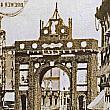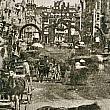Annotated Bibliography for the 1876 Centennial
by April Chernoby
Fitch, Geo. E.. Old Grand Rapids: A Picture History of Old Conditions. Grand Rapids, MI: Grand Rapids Historical Society, 1986.
The text offers a glimpse into the early architecture and cityscapes of Grand Rapids. While the value lies in the photographs the author also offers small summaries, which provide useful snapshots of the cities history. This book offered excellent visuals of life in the city during the American Centennial. This book would be a valuable resource for anyone doing research on early Grand Rapids history.
Grand Rapids Daily Eagle. October 1875 through July 1876.
The newspaper chronicled events for nearly fifty year in Grand Rapids beginning in 1856. The newspaper highlighted local, national, and international events. Pages three and four typically ran a number of advertisements of local businesses and featured editorials and short pieces on local and national events. The front page often offered a synopsis of local events, too. The paper closely followed the Centennial in Philadelphia, Grand Rapids, and the surrounding communities. In particular it features regular “Letters from the Centennial.”
Grand Rapids Daily Morning Democrat.
The newspaper became one of the leading Democratic papers in the State. It included an extensive editorial staff that offered quality articles on local, national, and to some extent international news. The paper usually ran four pages of news and advertisements. During the Centennial the paper offered great coverage of the Centennial celebration both in Grand Rapids and Philadelphia. The paper is of value to the local historian who is seeking information about the city during the mid-to-late nineteenth century and early twentieth century.
Grand Rapids Daily Morning Times. April through July 1876.
The Times, a popular Grand Rapids newspaper, followed area and national news closely. The paper would be comparable to the Daily Morning Democrat in terms of content. The first page offered short happenings around the area closely followed city affairs. For example, in 1876 the Mayor’s Message to the city appeared in its entirety. During the Centennial the paper offered numerous reports from Philadelphia and kept residence current on local happenings as well. The newspaper carried frequent advertisements featuring local businesses, real estate, and gimmicks. A historian could use the newspaper to gain a broad understanding of life in Grand Rapids. The paper ran from the mid-nineteenth through the mid-twentieth century.
Grand Rapids Public Library Photo Collection. Collection 54, Box 6, Folder 4, & Grand Rapids Public Library George E. Fitch Collection. Collection 66, Box 1, Folder 3.
Each of these collections is found in the archives at the Grand Rapids Public Library. Each collection featured an assortment of black and white photographs many of which dated back to the 1870’s. The images chronicle the development and daily life of the city. Many of the images have been used in history books on Grand Rapids. Although these images are accessible in secondary sources the size and quality is much better with the originals.
Grand Rapids Saturday Evening Post. June through July 1876.
This publication was produced once a week. While it carried local stories it offered much more then simple news stories. Many of the articles are editorials, short stories, or advice columns. The Post might be comparable to a Reader’s Digest. For instance, there are articles on courtships and relationships, health and home. The language tends to be more descriptive and creative. As a source, the Post provides the historian with a different perspective of attitudes and beliefs. This newspaper had very colorful descriptions of the Centennial.
Grand Rapids Weekly Democrat. May through June 1876.
A newspaper published every Wednesday but belonging to the creators of the Daily Democrat. The Weekly had a primary focus on politics, commodity prices, and the editors own rants and raves. While one can find a number of news stories on local and national events the articles often lack depth. Beyond the front page the remainder of the paper is littered with advertisements that become repetitive between issues. The Weekly however offered some interesting highlights the events leading up to the Centennial in Grand Rapids.
Louwerse, Cornelius. Story of My Childhood in Grand Rapids. Collection 263, Box 4.
A short memoir was written by a former resident of Grand Rapids. The memoirs highlight some important memories that Cornelius recalled as a child. The memoir is of value to the historian because it a rare account of growing up in Grand Rapids. Nonetheless, the accuracy of his accounts in called into question as a result of numerous inconsistencies in dates. This memoir should not be taken as fact because it is evident that it was written well after events occurred. The author was very reminiscent of the past and jumped from one memorable topic to the next. The author did offer his own interesting account of the Centennial in Grand Rapids.
Lydens, Z.Z.. A Look at Early Grand Rapids. Grand Rapids, MI: Kregel Publications, 1976.
The book is an extension of an earlier book written by the same author. Whereas the first book was a full text account of Grand Rapids’ history, this book recounts the history of Grand Rapids through text as well photographic evidence and illustrations. The text is broken into numerous chapters which focus on specific aspects of the city’s history (politics, the river, industry). While there was little on the Centennial the book did offer a broad description of what was happening during that general era. This book is an excellent starting point for anyone interested in research Grand Rapids’ history
Mapes, Lynn, and Travis, Anthony. A Pictorial History of Grand Rapids. Grand Rapids, MI: Kregel Publications, 1981.
This book, although mostly old photographs the book offers excellent descriptive summaries of key events in the city’s history. Unlike previous picture histories of the city the authors attempt to give a more in-depth explanation of the context surrounding the photos. Furthermore, the photographs and brief histories cover a much larger time period, chronically this history of Grand Rapids from its birth through its publishing date.
Rydell, Robert. All the World’s a Fair. Chicago: University of Chicago, 1984.
The book highlights all of the World’s Fair held in the United State from the mid-nineteenth century through the early twentieth century. While the author tries to show that the Fairs’ symbolized America’s growth and progress he takes a personal somewhat unconvincing stance on race. The goal of his book is to show that the Fairs were elitists and exploited race. Nonetheless, the book provided interesting facts about the Philadelphia Exposition.
U.S. Bureau of the Census. Population of the 100 Largest Urban Places: 1870 & 1880.
The U.S. Census Bureau is an invaluable source for statistics about demographics and population in the United States. I found the link for the Population of the 100 Largest Urban Areas extremely helpful for data on early American cities. However, this is certainly the place for any researcher to begin his or her’s research on populations or cities.

 facebook
facebook



